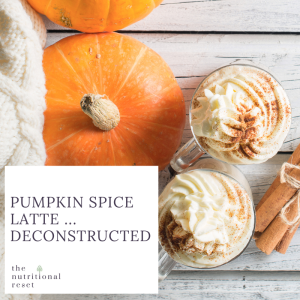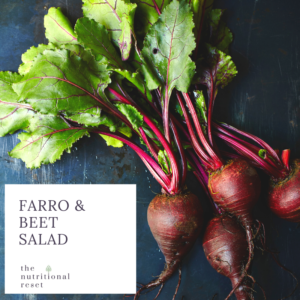
I can’t seem to get enough of this Farro & Beet Salad! It’s a deliciously satisfying combo of earthy roasted beets and garlic tossed with nutty, chewy farro and simply dressed with extra virgin olive oil, fresh lemon and dill. The flurry of microgreens adds colour and boosts nutrition. Even better, microgreens make me think of spring right around the corner. So close, you can taste it!
You may recall from last month’s recipe post that broccoli sprouts are powerhouses of sulforaphane, a compound that acts against the formation of cancer at the molecular level. Broccoli microgreens are the next best thing. Living Earth Farm grows broccoli microgreens as well as several other varieties right here in Toronto. I’ve also made this salad using their basil microgreens and their cilantro microgreens (I told you I can’t seem to get enough of this salad) and each worked beautifully.
If your beets have greens that are as gorgeous as the ones in the photo, chiffonade them into the salad as well as (or instead of) the microgreens. Other bitter greens like arugula, dandelion or radicchio are also fantastic additions.
This Farro & Beet Salad is wonderful warm or at room temperature and can easily be made ahead. Feel free to scale up the recipe to serve a crowd. I like to crumble feta or goat cheese over top and sprinkle it with toasted pumpkins seeds. And it plays well with just about anything, roasted chicken and salmon being my current favourites. For a meatless meal, add about a cup of cooked chickpeas per serving.
Sign up to my newsletter today to receive the recipe for this scrumptious Farro & Beet Salad. And read on for more about why I’ve been craving this salad and the bevy of benefits from feasting on farro and beets
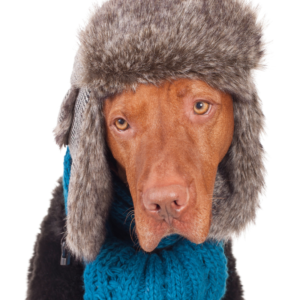 Is anyone else feeling the February blahs? It’s not uncommon to battle the blues mid-winter, so I thought I’d offer up some February blahs busters, as well as invite you to contribute yours. You won’t be surprised that they are related to diet and exercise. But that’s not only because of my profession (and passion). It’s because they truly work.
Is anyone else feeling the February blahs? It’s not uncommon to battle the blues mid-winter, so I thought I’d offer up some February blahs busters, as well as invite you to contribute yours. You won’t be surprised that they are related to diet and exercise. But that’s not only because of my profession (and passion). It’s because they truly work.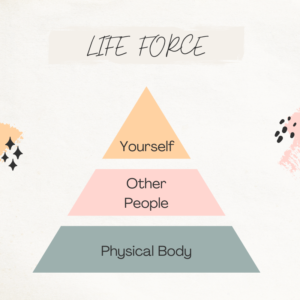 The first layer of this is to get your physical body working, in terms of proper diet, exercise and sleep. What really caught my attention was Stutz saying that improving these three things can account for 85% of the initial improvements in mental health. I repeat, 85%! And what is so empowering about this is that beneficial changes in these areas are well within our grasp.
The first layer of this is to get your physical body working, in terms of proper diet, exercise and sleep. What really caught my attention was Stutz saying that improving these three things can account for 85% of the initial improvements in mental health. I repeat, 85%! And what is so empowering about this is that beneficial changes in these areas are well within our grasp.
 supplements are big business. According to Types of Supplements: 2022–2023 Trends, a report from NutraScience Labs, the global market is projected to increase to US$272.4 billion by 2028. Regulatory practices vary widely
supplements are big business. According to Types of Supplements: 2022–2023 Trends, a report from NutraScience Labs, the global market is projected to increase to US$272.4 billion by 2028. Regulatory practices vary widely 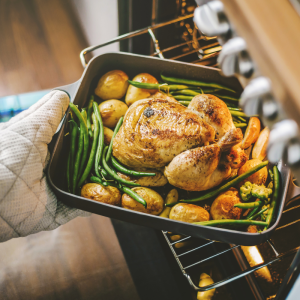 Happy New Year! As holiday feasting has come to a close along with 2022, thoughts have likely turned toward New Year’s resolutions to be healthier and/or lose weight in 2023. The plethora of diets out there (Mediterranean, DASH, Paleo, Keto, Low FODMAP, Vegan, Low Carb-High Fat, Low Fat-High Carb, MIND, Weight Watchers and many more) can easily have you calorie counting, confused and stressing over micro-managing your macro-nutrients (“gee, how many grams of fat, protein and carbs should I eat?“).
Happy New Year! As holiday feasting has come to a close along with 2022, thoughts have likely turned toward New Year’s resolutions to be healthier and/or lose weight in 2023. The plethora of diets out there (Mediterranean, DASH, Paleo, Keto, Low FODMAP, Vegan, Low Carb-High Fat, Low Fat-High Carb, MIND, Weight Watchers and many more) can easily have you calorie counting, confused and stressing over micro-managing your macro-nutrients (“gee, how many grams of fat, protein and carbs should I eat?“). We’re in the bell lap of 2022 and the holiday season is officially in top gear. A few years ago I offered up some timeless tips on how to
We’re in the bell lap of 2022 and the holiday season is officially in top gear. A few years ago I offered up some timeless tips on how to 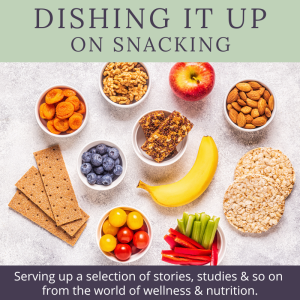
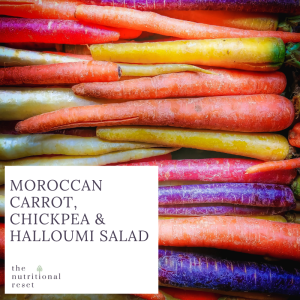
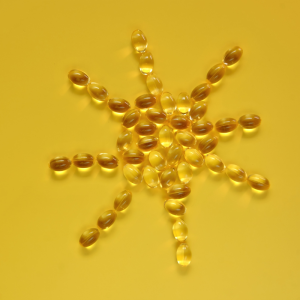 To D or not to D – that is the question. I’m referring, of course, to vitamin D and whether it’s a good idea to take a vitamin D supplement. Here are some multiple choice answers for you to ponder:
To D or not to D – that is the question. I’m referring, of course, to vitamin D and whether it’s a good idea to take a vitamin D supplement. Here are some multiple choice answers for you to ponder: